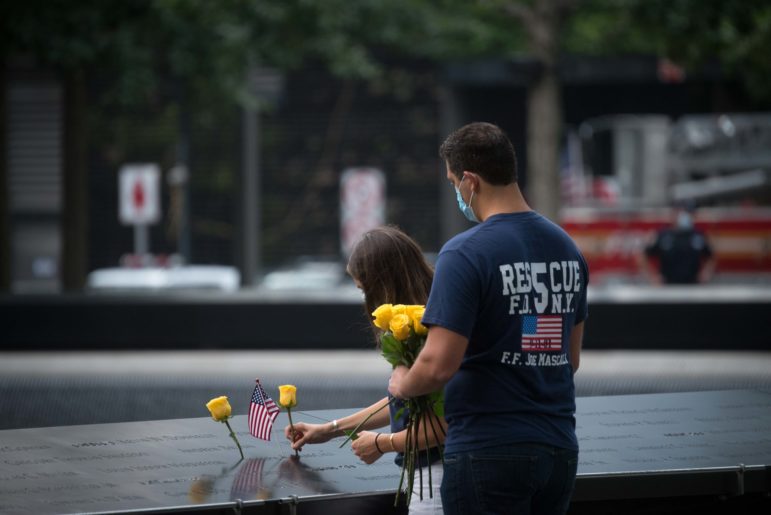In the last five years, there has been an increase in cancer, and a significant increase in leukemia cases, among the more than 80,000 general responders and firefighters enrolled in the World Trade Center Health Program, according to an analysis published last week.

Michael Appleton/Mayoral Photography Office
Visitors pay their respects at the 9/11 memorial in Lower Manhattan.Shortly before the 20th anniversary of the 9/11 terrorist attacks, a new study on the health of first responders reveals new trends in prominent conditions linked to contaminants at the site.
In the last five years, there has been an increase in cancer, and a significant increase in leukemia cases, among the more than 80,000 general responders and firefighters enrolled in the World Trade Center Health Program, according to analysis by Erin Smith and her colleagues of Edith Cowan University’s School of Medical and Health Sciences in Perth, Australia.
Leukemia has become more prominent among first responders than bladder and colon cancers, with a 175 percent increase in cases since 2016. Still, it remains only the seventh most common cancer, falling well behind skin and prostate cancer, which combined comprise about 64 percent of the cancers reported across the group.
Smith, whose findings were published Sept. 2 in Cambridge University Press, said it’s possible rates of leukemia are upticking now may be simply because the illness took nearly 20 years after exposure to develop. Leukemia is linked to benzene exposure, resulting from the burning of jet fuel.
“It may be that previous research studies have been conducted too early to pick up on any elevated risk,” she said. She also noted that age and smoking can put someone at higher risk of leukemia. “If someone is at higher risk, such as a smoker or being older, then exposure to environmental toxins such as benzene may increase the risk more.”
In the last five years, there has also been an increase in lung conditions related to asbestos exposure among the health program enrollees, according to the analysis. Mesothelioma, an aggressive cancer also related to asbestos exposure, is a concern for this population, the study notes, because it can take 20 to 50 years to develop after exposure.
“This long-running threat is finally coming to fruition,” Smith told City Limits. “Eighteen years after Manhattan was engulfed in the asbestos-laced, toxic cloud of dust, the first death from mesothelioma among 9/11 responders was recorded. I’m sure there will be more.”
Previous research has noted that more than 2,000 tons of asbestos were used in the construction of the World Trade Center towers. The new study notes that the trends should be “viewed with caution,” since a number of factors can impact one’s susceptibility to certain illnesses—and “heightened surveillance” of first responders could also be part of the uptick, rather than an actual increase in disease. “Still, cancer in general, as well as lung disease, heart disease, and posttraumatic stress disorder (PTSD), seem to be increasing among 9/11 responders, even now close to 20 years later,” an abstract for the study states.
The most prominent overall health condition among the health program participants, according to Smith’s research, is asthma, with more than 132,000 responders affected.
More than 400,000 individuals were exposed to toxic dust in the aftermath of the attacks, the Centers for Disease Control and Prevention reported. One week after the attacks, Christie Whitman, then-administrator of the Environmental Protection Agency, publicly announced that there was no risk of toxins near the sites.
“We are very encouraged that the results from our monitoring of air quality and drinking water conditions in both New York and near the Pentagon show that the public in these areas is not being exposed to excessive levels of asbestos or other harmful substances,” she said in a Sept.18 press release that year. “Given the scope of the tragedy from last week, I am glad to reassure the people of New York and Washington, D.C. that their air is safe to breathe and their water is safe to drink.”
A report two years later by the EPA’s inspector general’s office found that the agency “did not have sufficient data and analyses to make such a blanket statement.”
“At that time, air monitoring data was lacking for several pollutants of concern, including particulate matter and polychlorinated biphenyls (PCBs),” the report said. It also added that the White House influenced information that the EPA communicated to the public when “it convinced EPA to add reassuring statements and delete cautionary ones.” Whitman later apologized, saying the EPA “did the very best we could at the time with the knowledge we had.”
Years later, effects of exposure continue to reveal themselves, including as comorbidities during the COVID-19 pandemic. More than 100 first responders from 9/11 have died from Covid-19, the study says.
“Increasing numbers of 9/11 responders are enrolling into the WTCHP each year, indicating that their health and well-being is getting worse, not better,” said Smith. “Those who ran into the burning buildings that day, who climbed over, under and through the still-smouldering rubble while breathing in toxic dust for months, continue to pay a heavy price for their bravery.”








